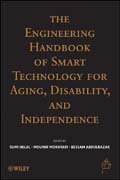
The engineering handbook of smart technology for aging, disability and independence
Helal, Abdelsalam
The Engineering Handbook of Smart Technology for Aging, Disability and Independence provides a thorough introduction to the technologies promoting independence for older persons as they face age related declines and age related chronic conditions. Written by experts in their fields, chapters cover such topics as device and computer accessibility, home automation to support independence,assistive robotics, smart environments, and emerging standards in and the future of elder care. An ideal text for graduate students and professionals in computer science, rehabilitation science, and clinical engineering. INDICE: Preface (Sumi Helal, Mounir Mokhtari and Bessam Abdulrazak). Introduction to the book (1 Sumi Helal, Mounir Mokhtari, Bessam Abdulrazak and MarkSchmalz). PART 1: DEFINITIONS, CLASSIFICATIONS AND POLICIES. Chapter 1: Technology for Successful Aging and Disabilities (Amol Karmarkar, Eliana Chavez andRory A. Cooper). Chapter 2: International Policy Context of Technologies for Disabilities: An Analytical Framework (Rene Jahiel). Chapter 3: Technology forIndividuals with Disabilities: Government and Market Policies (Katherine D. Seelman). Chapter 4: Assistive Technology and the International Classification of Functioning, Disability and Health (Jerome Bickenbach). Chapter 5: Technology for Integration of Students with Disabilities in Higher Education (Marci Kinas Jerome, Kristine Neuber, Brianna Stegall, Anna Emenova and Michael Behrmann). Chapter 6: ISO 9999 Assistive Products for Persons with Disability - Classification and Terminology (Ir. Theo Bougie). PART 2: USERS, NEEDS AND ASSISTIVE TECHNOLOGY. Chapter 7: Low Tech Assistive Technology (Kathleen Laurin and Jill Sherman). Chapter 8: People with Visual Disabilities (John Gill and Linda Newson). Chapter 9: Assistive Devices for People with Visual Impairments (John Gill). Chapter 10: Assistive Devices for People with Hearing Loss (Matthew H. Bakke). Chapter 11: People with Cognitive Disabilities (Mary Kay Rizzolo and David Braddock). Chapter 12: Assistive Devices for People with Cognitive Impairments (Hélène Pigot, Jérémy Bauchet and Sylvain Giroux). PART 3: HUMAN MACHINEINTERACTION and ALTERNATIVE COMMUNICATION. Chapter 13: Computer Access in theWorkplace (Karen Milchus and Carrie Bruce). Chapter 14: Platforms and Operating Systems Accessibility (Barry Feigenbaum and Kip Harris). Chapter 15: Voice Interactive Systems (Rudzionis Algimantas, Kastytis Ratkevicius and Vytautas Rudzionis). Chapter 16: The Communication Assistant (Alternative Communication)(Leanne West). Chapter 17: Wearable Systems Design Issues for Aging or Disabled Users (Maribeth Gandy, Tracy Westeyn, Helene Brashear and Thad Starner). Chapter 18: Tactile Displays (Stephen A. Brewster, Steven A. Wall, Lorna M. Brown and Eve E. Hoggan). PART 4: ASSISTIVE ROBOTICS. Chapter 19: Assistive Robotics for Independent Living (Bessam Abdulrazak and Mounir Mokhtari). Chapter 20:Mobile Platform-Based Assistive Robot Systems (Zeungnam Bien, Dae-Jin Kim, Kwang-Hyun Park, Jin-Woo Jung, Jin-Oh Kim, Myung Jin Chung and Pyung-Hun Chang).Chapter 21: Robot Therapy at Elderly Institution - Effects of Long-Term Interaction with Seal Robots (Takanori Shibata and Kazuyoshi Wada). Chapter 22: Prostheses - Human Limbs and Their Artificial Replacements (Richard F. ff. Weir).PART 5: USER MOBILITY. Chapter 23: Wheelchairs within the Context of Smart House Design (Dimitar Stefanov). Chapter 24: People with Special Needs and Traffic Safety (Nahid Shahmehri, Ioan CHISALITA and Iohan Aberg). Chapter 25: BlindNavigation and the Role of Technology (Nicholas Giudice and Gordon Legge). Chapter 26: Walker Systems (Andrew Rentschler). Chapter 27: Accessible Public Transportation Services in America (Katharine M. Hunter-Zaworski). Chapter 28: Transportation Services in Europe (Isabelle Dussutour). Chapter 29: Transportation Services in Asia (Joseph Kwan and Eric W.C. Tam). PART 6: TECHNOLOGIES FORSMART ENVIRONMENTS. Chapter 30: Modeling the Well-Being of Older People (Andrew Sixsmith). Chapter 31: Context Awareness (Jadwiga Indulska and Karen Henricksen). Chapter 32: Middleware for Smart Spaces (Daqing Zhan,g Tao Gu and ManliZhu). Chapter 33: Privacy, Security and Safety Technologies (Abdallah M'hamed). Chapter 34: Automated Medication Management Devices (RJ Davies, ChristopherNugent, DD Finlay, D Craig and ND Black). Chapter 35: Virtual Companions (Nahid Shahmehri, Johan berg and Dennis Maciuszek). Chapter 36: Textile Sensing and e-Textile (Smart Textile) (Rita Paradiso, Nicola Taccini and Giannicola Loriga). Chapter 37: Audio Games Enjoyed by Players with Vision Impairments (ChrisHofstader). PART 7: SMART ENVIRONMENTS AND CYBER-INFRASTRUCTURES . Chapter 38: The Gator Tech Smart House: A Programmable Pervasive Space (Sumi Helal). Chapter 39: Health Application and Tele-care (Mathijs Soede, Frank Vlaskamp and Charles Willems). Chapter 40: Immersive Tele-Care for Assisting People with Special Needs (Sumi Helal and Bessam Abdulrazak). Chapter 41: Smart Systems in Personal Transportation (Aaron Steinfeld). Chapter 42: Tools for Studying Novel Proactive HealthCare Applications for Places of Living (Stephen Intille and Kent Larson). Chapter 43: Algorithms for Smart Spaces (Diane J. Cook, G. MichaelYoungblood and Gaurav Jain). PART 8: EMERGING STANDARDS, GUIDELINES and DESIGN METHODS. Chapter 44: User Sensitive Design for Older and Disabled People (Alan Newell). Chapter 45: Universal design/Design for All? Practice and Method (Edward H Steinfeld). Chapter 46: Design for Well-being (Andreas Larsson and Tobias Larsson). Chapter 47: Technology Evaluation within Health and Social Care(Suzanne Martin, George Kernohan, Bernadette Mc Creight and Christopher Nugent). Chapter 48: Usability in Designing Assistive Technologies (Jean-Claude SPERANDIO and Marion Wolff). Chapter 49: Smart Home and Health Telematics: Standards for and with Users (Milan Erbes). Chapter 50: ICT Standardization for Elderly and People with Disabilities in Japan (Hajime Yamada).
- ISBN: 978-0-471-71155-1
- Editorial: John Wiley & Sons
- Encuadernacion: Cartoné
- Páginas: 960
- Fecha Publicación: 26/09/2008
- Nº Volúmenes: 1
- Idioma: Inglés
